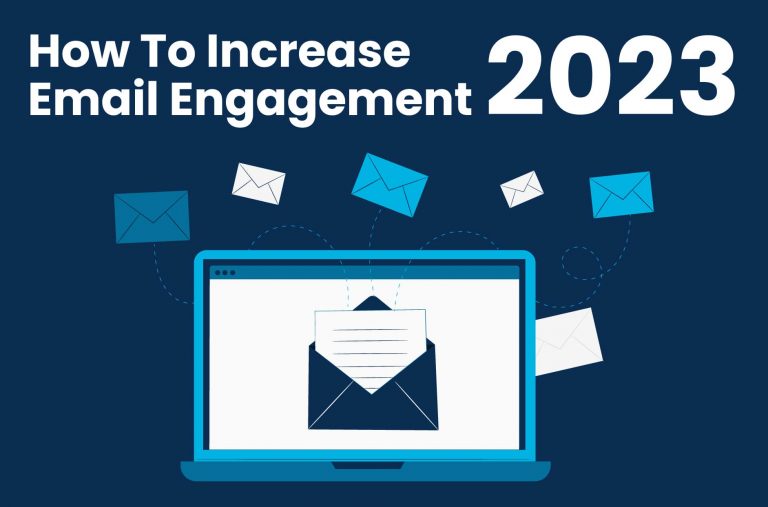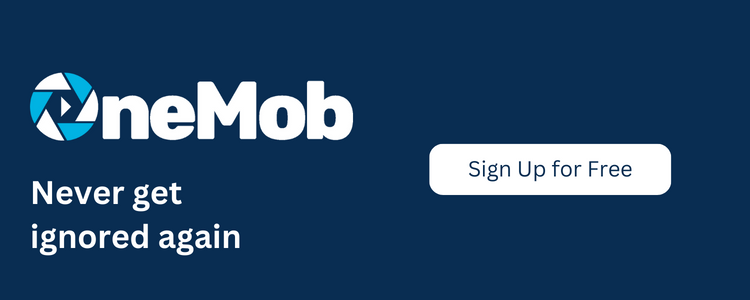Having a good understanding of what email engagement is and how to increase it is vital when running a marketing campaign.
Table of Content
- Why is Having Good Email Engagement Relevant to Email Marketing?
- The Benefits of Increasing Email Engagement in Email Marketing
- The Different Types of Email Marketing
- What Should Be Avoided in Email Marketing?
- How Can You Improve Email Performance?
- The Best Ways to Attract Customers Through Emails
- Tips For Increasing Email Engagement
- How to Measure Success in Email Marketing
- Final Thoughts
What is email engagement? Email engagement measures how customers or subscribers react to an email marketing campaign.
This is done by looking at and studying several different standard metrics, such as open rate, unsubscribe rate, click-through rate, click map, and click traffic.
Understanding how your subscribers respond to each campaign can help you improve those campaigns so that they reach a broader audience (more people opening your emails) and ultimately achieve greater success.
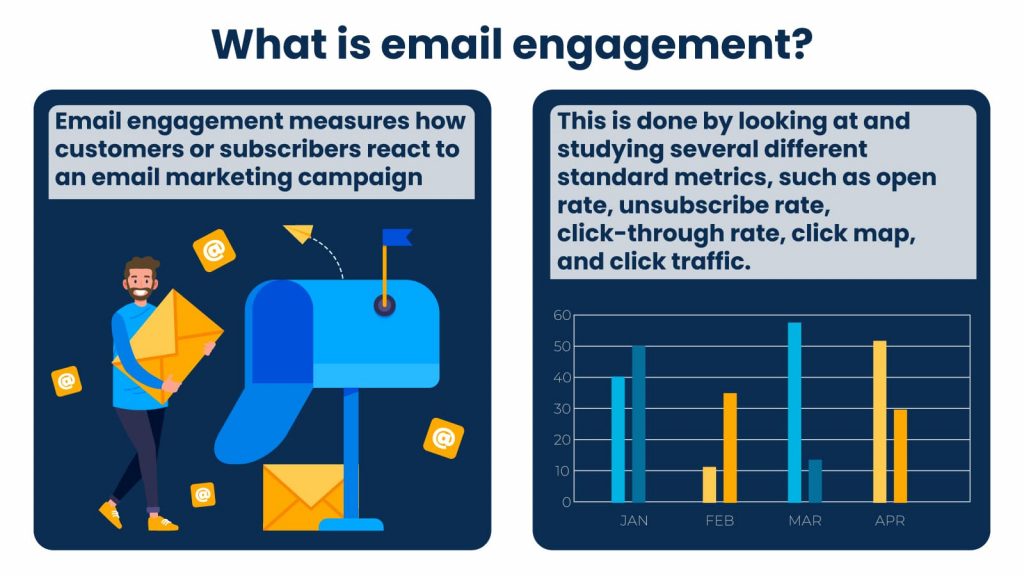
In this guide, you will learn more about email marketing, what it is, how to construct a campaign, the different types of email marketing, and tips for success.
Why is Having Good Email Engagement Relevant to Email Marketing?
Although email marketing can be a powerful tool for any business or entrepreneur, without the right engagement, it could feel like you are spinning your wheels.
Setting a goal to increase email engagement (and then reaching that goal) will be a significant stepping stone to your success.
Even though good engagement is undoubtedly important, you will only know your engagement if you learn to track your progress.
Tracking your progress will save you time over the long term and help you succeed. Email tracking software allows you can track things like bounce, unsubscribe, and delivery rates.
By analyzing this information and comparing it to that of other campaigns, you can quickly see what does and does not work.
Email marketing should be a significant part of your marketing efforts, especially because your competition uses it. Here are some interesting stats to consider:
- 4 billion people use email daily.
- 37% of brands are increasing their email budgets.
- 1/3 of all marketers send weekly emails, and ¼ send several emails monthly.
- It is estimated that email marketing revenue will reach 11 billion dollars by the end of 2023.
Those are exciting stats, but it is essential to note that to be successful, you must track your results and adjust accordingly.
Email marketing is typically a cheaper marketing tool that can end in a higher return than other methods.
By using email marketing effectively, you will also be able to build brand awareness, credibility and improve customer relations.
The Benefits of Increasing Email Engagement in Email Marketing
If you are looking for ways to increase email engagement, you might be interested in its benefits. The most significant advantage is that this is an inexpensive way to advertise your business. Other benefits of email marketing include:
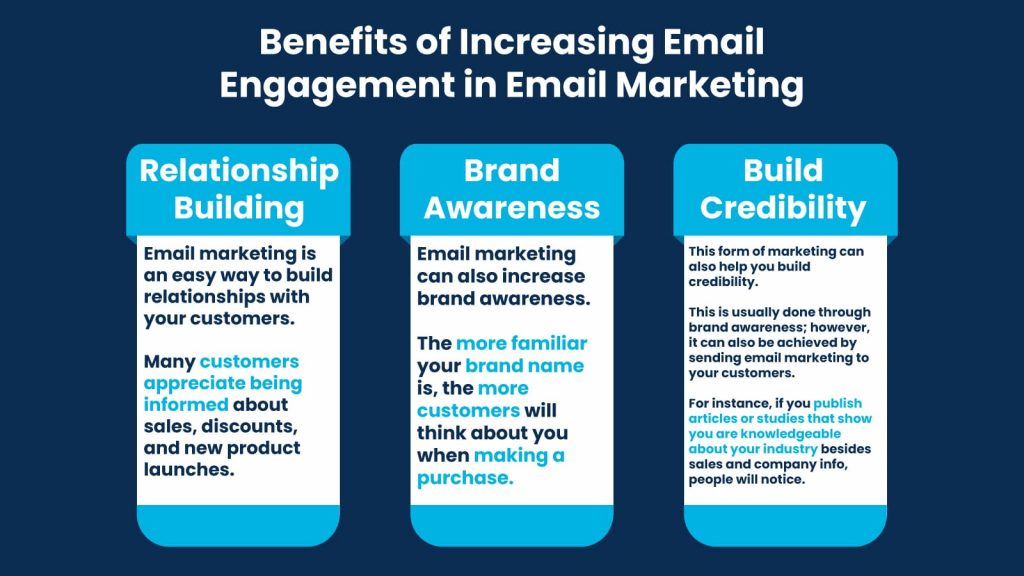
Relationship Building
Email marketing is an easy way to build relationships with your customers. Many customers appreciate being informed about sales, discounts, and new product launches.
Brand Awareness
Email marketing can also increase brand awareness. The more familiar your brand name is, the more customers will think about you when making a purchase.
Build Credibility
This form of marketing can also help you build credibility. This is usually done through brand awareness; however, it can also be achieved by sending email marketing to your customers. For instance, if you publish articles or studies that show you are knowledgeable about your industry besides sales and company info, people will notice.
As previously mentioned, even though email marketing can be much cheaper to launch than other forms of marketing and advertising, the ROI can be high. Running an email campaign is inexpensive, but the return can exponentially increase depending on the call to action.
The Different Types of Email Marketing
If you’re new to internet marketing, there are different types of marketing to try. We will mention several examples of the most popular here. Be sure to try a few different varieties to increase email engagement.
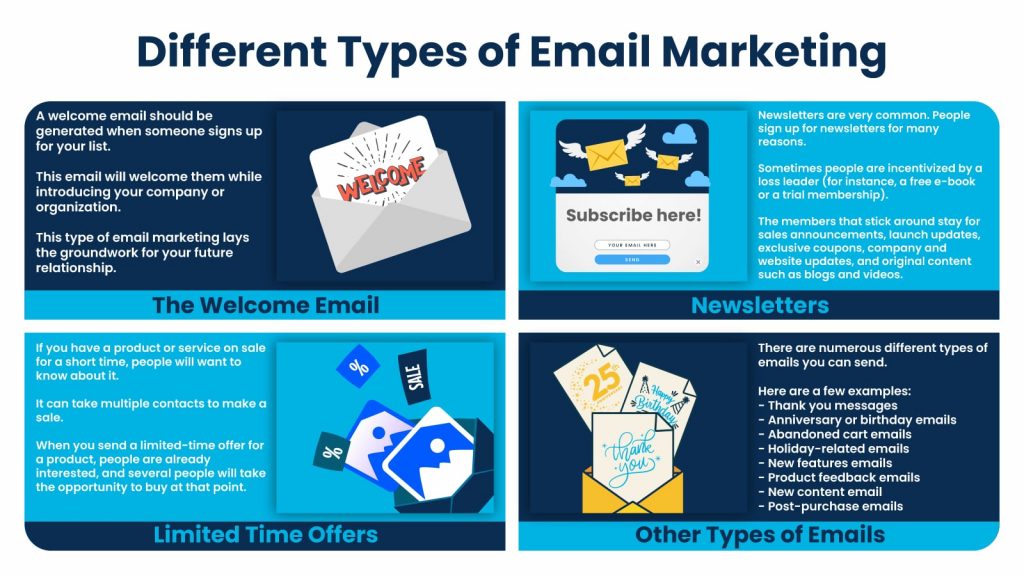
The Welcome Email: A welcome email should be generated when someone signs up for your list. This email will welcome them while introducing your company or organization. This type of email marketing lays the groundwork for your future relationship.
Newsletters. Newsletters are very common. People sign up for newsletters for many reasons.
Sometimes people are incentivized by a loss leader (for instance, a free e-book or a trial membership). The members that stick around stay for sales announcements, launch updates, exclusive coupons, company and website updates, and original content such as blogs and videos.
Limited Time Offers. If you have a product or service on sale for a short time, people will want to know about it. It can take multiple contacts to make a sale.
When you send a limited-time offer for a product, people are already interested, and several people will take the opportunity to buy at that point.
Other Types of Emails. There are numerous different types of emails you can send. Here are a few examples:
- Thank you messages
- Anniversary or birthday emails
- Abandoned cart emails
- Holiday-related emails
- New features emails
- Product feedback emails
- New content email
- Post-purchase emails
What Should Be Avoided in Email Marketing?
Although email marketing is crucial and can be a lucrative part of your business model, there is a right and wrong way to go about this type of marketing. If you are committed to finding ways to increase email engagement, you must avoid the following mistakes.
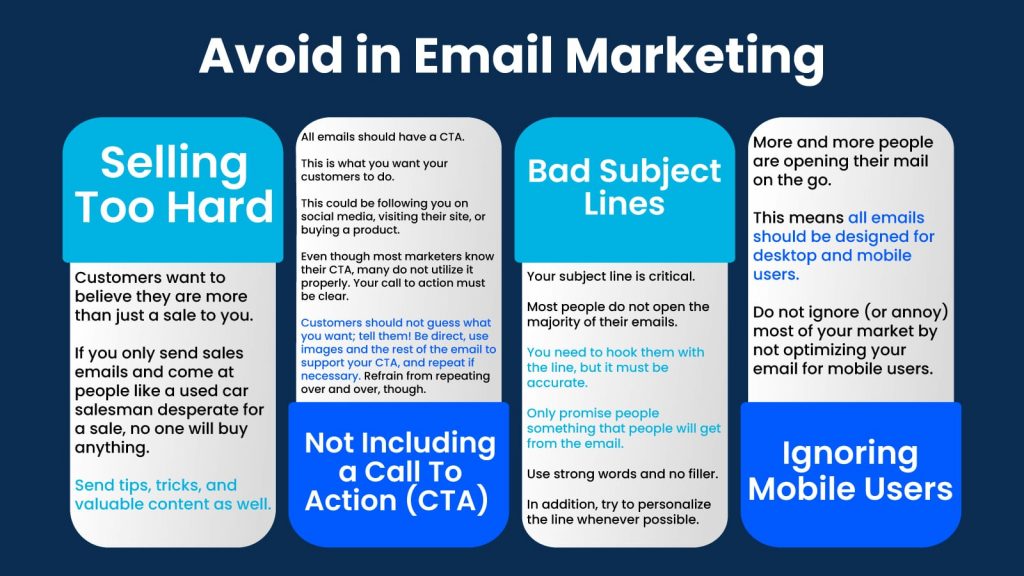
Selling Too Hard. Customers want to believe they are more than just a sale to you. If you only send sales emails and come at people like a used car salesman desperate for a sale, no one will buy anything. Send tips, tricks, and valuable content as well.
Not Including a Call To Action (CTA). All emails should have a CTA. This is what you want your customers to do. This could be following you on social media, visiting their site, or buying a product.
Even though most marketers know their CTA, many do not utilize it properly. Your call to action must be clear.
Customers should not guess what you want; tell them! Be direct, use images and the rest of the email to support your CTA, and repeat if necessary. Refrain from repeating over and over, though.
Bad Subject Lines. Your subject line is critical. Most people do not open the majority of their emails. You need to hook them with the line, but it must be accurate.
Only promise people something that people will get from the email. Use strong words and no filler. In addition, try to personalize the line whenever possible.
Ignoring Mobile Users. More and more people are opening their mail on the go. This means all emails should be designed for desktop and mobile users. Do not ignore (or annoy) most of your market by not optimizing your email for mobile users.
How Can You Improve Email Performance?
One of the ways you can increase email engagement is by improving the emails you send to your customers and subscribers. Let’s Look at ways to do this effectively.
Quality over Quantity. You might be tempted to send a lot of emails. It makes sense. The more emails you send, the more money you can make. However, this is a mistake. You should focus on sending quality messages.
People that have signed up to hear from you want to listen to what you have to say. However, each email must add value to them. If your emails do not add value, they will stop opening your emails, and could even have them unsubscribe from your list.
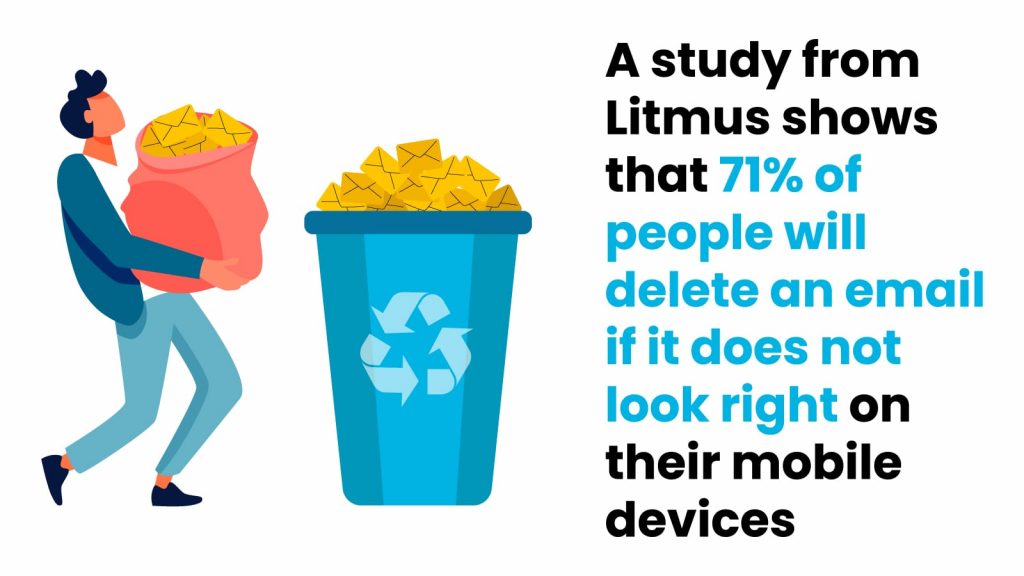
Mobile-Friendly Messages. A study from Litmus shows that 71% of people will delete an email if it does not look right on their mobile devices.
This is the importance of designing a mobile-friendly message. With open rates low already, you do not want to lose more than 2/3 of your potential customers because your message is only optimized for desktop users.
Personalized Messages. Personalized messages can be the difference between a click-through and a delete. You can personalize it in several different ways.
One idea is to create segmented lists. You can have a full mailing list and other mailing lists divided into specific interest categories.
Test and Track Your Campaigns. One of the best ways to improve your campaigns is to track your results and participate in A/B testing.
A/B testing happens when you send one email to one group and another email to another. You can test formats (text only versus text and image), content, how you write your CTA, and send times.
Send Multiple Types of Emails. One way to get more open emails and interactions is to send multiple types of emails. This can include sales, launch updates, content-based emails, polls, and interactive emails.
The Best Ways to Attract Customers Through Emails
You may have heard the phrase, “the money is on the list.” Whereas this is a true statement, the list has to be cultivated correctly for campaigns to run well.
For instance, many people will hear this statement and decide that if the money is on the list, they should build it as quickly as possible.
However, this usually involves buying customer names for a list. This is the exact wrong way to go. Names with no direct interest in your company will not want to read your emails.
Non-targeted email addresses are a waste. They will not respond favorably; it is money you spend with no return, and, depending on where you got the names, it may not even be legal.
If you want a good relationship and higher email engagement, you need to attract customers to your list.
Get subscriptions and send out the right information. This includes content updates, valuable free information, promotions, and one-time deals.
Consider sprinkling in emails for limited-time offers as well as giveaways. Giveaways can help with click-through rates but can also be designed for more engagement.
Have your email subject line mention the giveaway, then have the email go to a landing page. This landing page should have steps for the reader to follow to enter. This can entice people to your website or product page or engage them on your social media accounts.
Tips For Increasing Email Engagement
There are many different methods you can use to increase email engagement. Let’s look at some additional ideas to try in your campaigns.
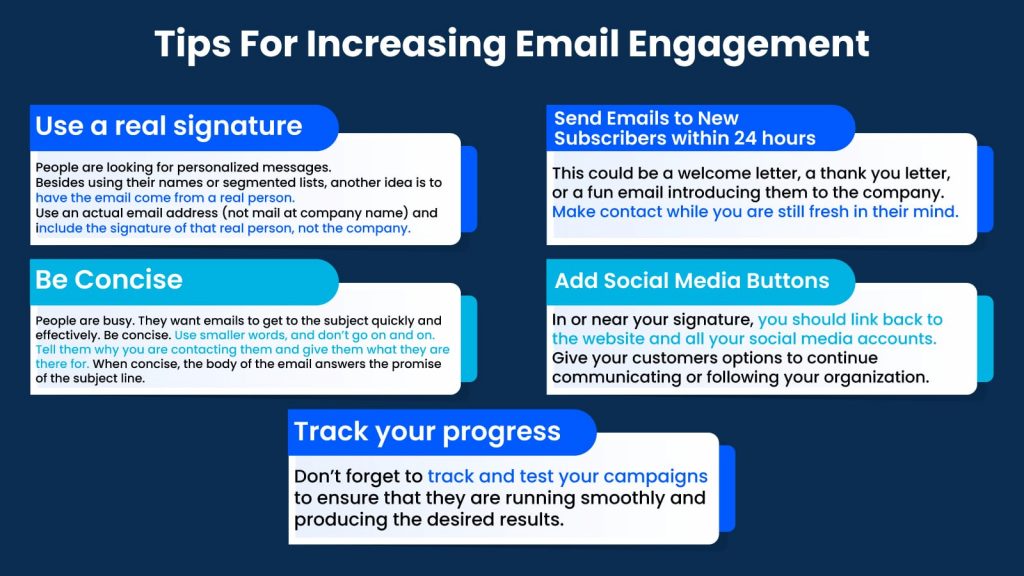
Use a real signature. People are looking for personalized messages. Besides using their names or segmented lists, another idea is to have the email come from a real person. Use an actual email address (not mail at company name) and include the signature of that real person, not the company.
Send Emails to New Subscribers within 24 hours. This could be a welcome letter, a thank you letter, or a fun email introducing them to the company. Make contact while you are still fresh in their mind.
Be Concise. People are busy. They want emails to get to the subject quickly and effectively. Be concise. Use smaller words, and don’t go on and on.
Tell them why you are contacting them and give them what they are there for. When concise, the body of the email answers the promise of the subject line.
Add Social Media Buttons. In or near your signature, you should link back to the website and all your social media accounts. Give your customers options to continue communicating or following your organization.
Track your progress. Don’t forget to track and test your campaigns to ensure that they are running smoothly and producing the desired results.
How to Measure Success in Email Marketing
When you want to increase email engagement, it’s crucial to measure the success of each campaign.
Depending on your end goal, there are many different ways to be successful. Some success indicators include increased revenue, brand recognition, social media followers, and website traffic.
Let’s look at some of these ways to measure how successful your email campaigns are.
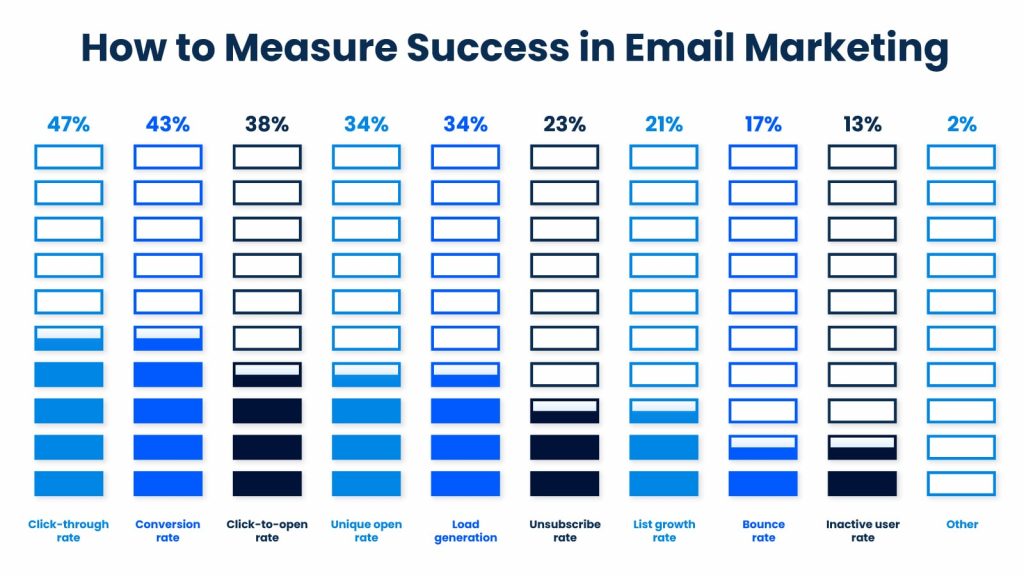
Bounce Rate. Using this metric, you will look at the bounce rate on the landing page (or interior page your emails are linking to).
If people come to your site but quickly bounce, leaving without any action, this could be a problem. The page may not live up to what the email is selling.
Conversion Rate. The conversion rate is the number of conversions divided by the number of delivered mail multiplied by 100.
A conversion is an action you discussed in your CTA, like purchasing a product, following on social media, or visiting a page on your website.
Click Rate. The click rate is the percentage of people who opened the email and clicked on a link to a landing page, your website, or linked social media accounts.
Website Traffic. You can also look at the traffic received from the email. To use this metric, you must first set something up in tracking software. Otherwise, common tools like Google Analytics default to clicks being direct traffic.
Revenue. Finally, you can look at associated revenue. How many sales did you make from this campaign?
To determine the Return on Investment (ROI), you can divide the profit by the amount you spent on an individual campaign.
Final Thoughts
There are many different ways to increase email engagement. Remember, email marketing campaigns are a low-cost way to drive traffic and brand recognition and increase sales to your business.
Before you get started, be sure to have some way to track your performance. Do not take shortcuts. This includes taking the time to cultivate a list instead of buying one.
You will also want to send quality emails that deliver on the promise set forth by an engaging and clickable subject line.
Finally, make sure you avoid falling into a rut. Experiment with different types of emails, including limited-time promotions, content updates, and polls.
Remember to also add a little personality and personalize your messages.

